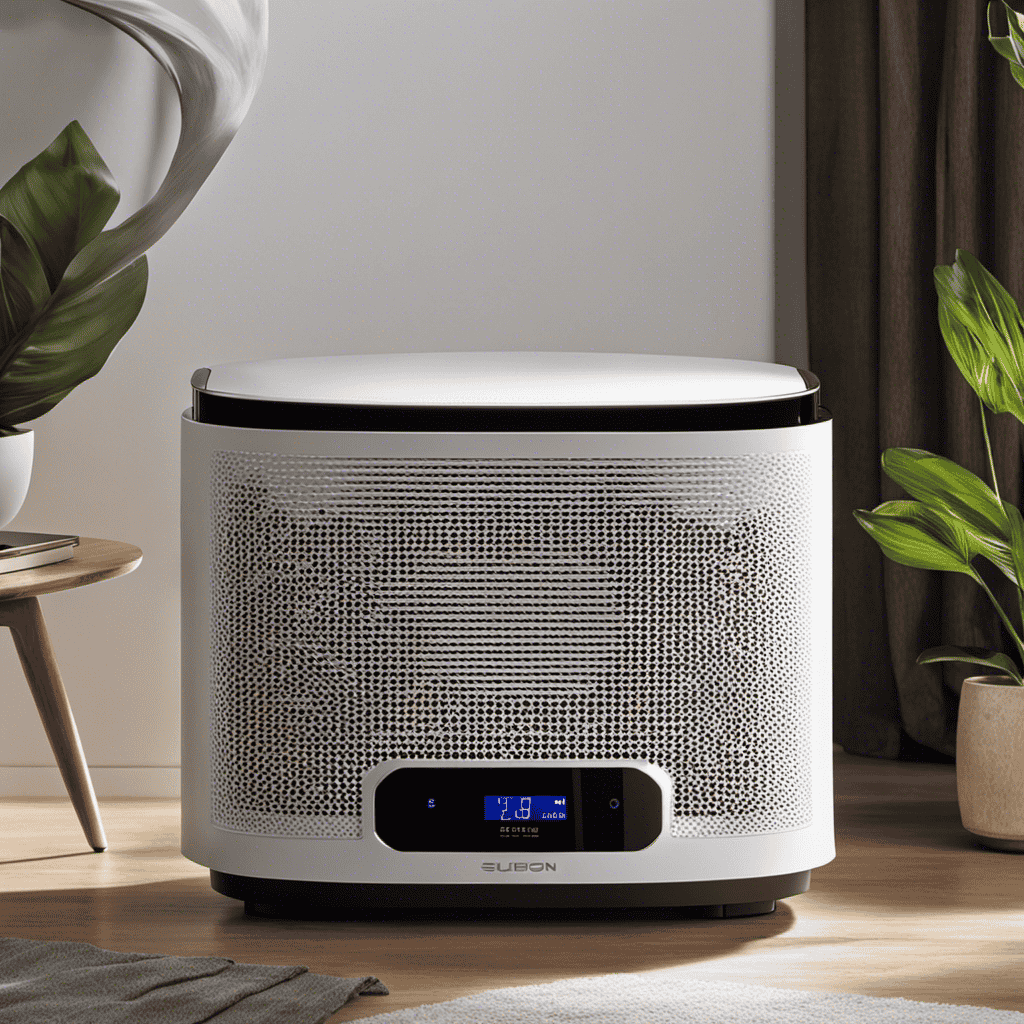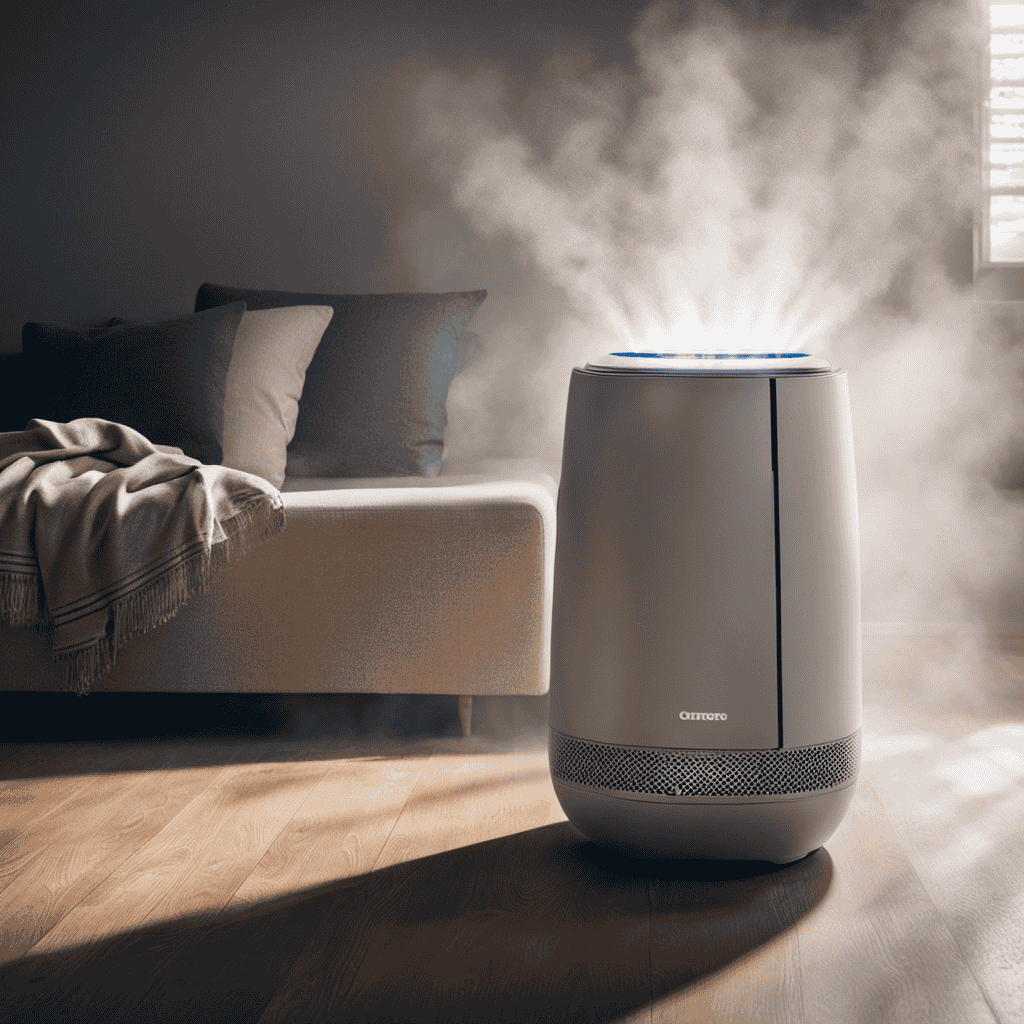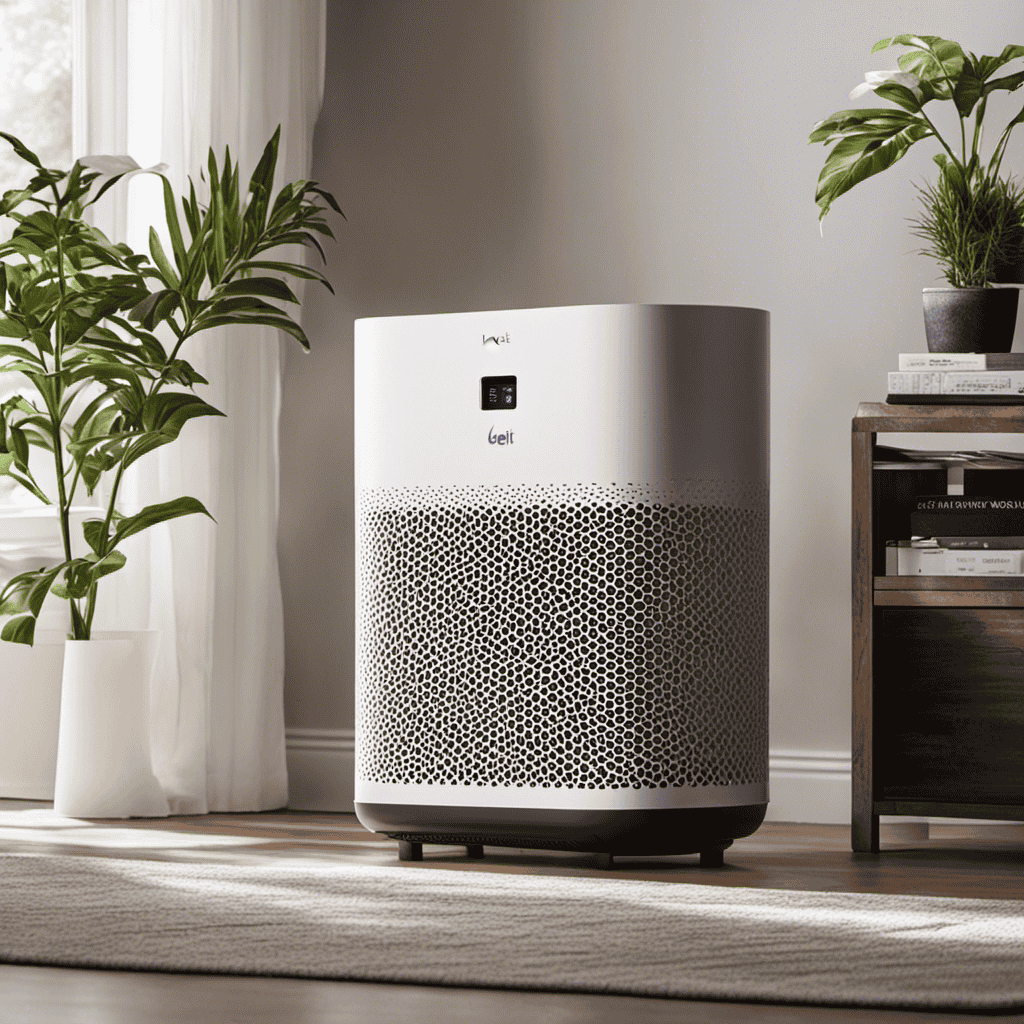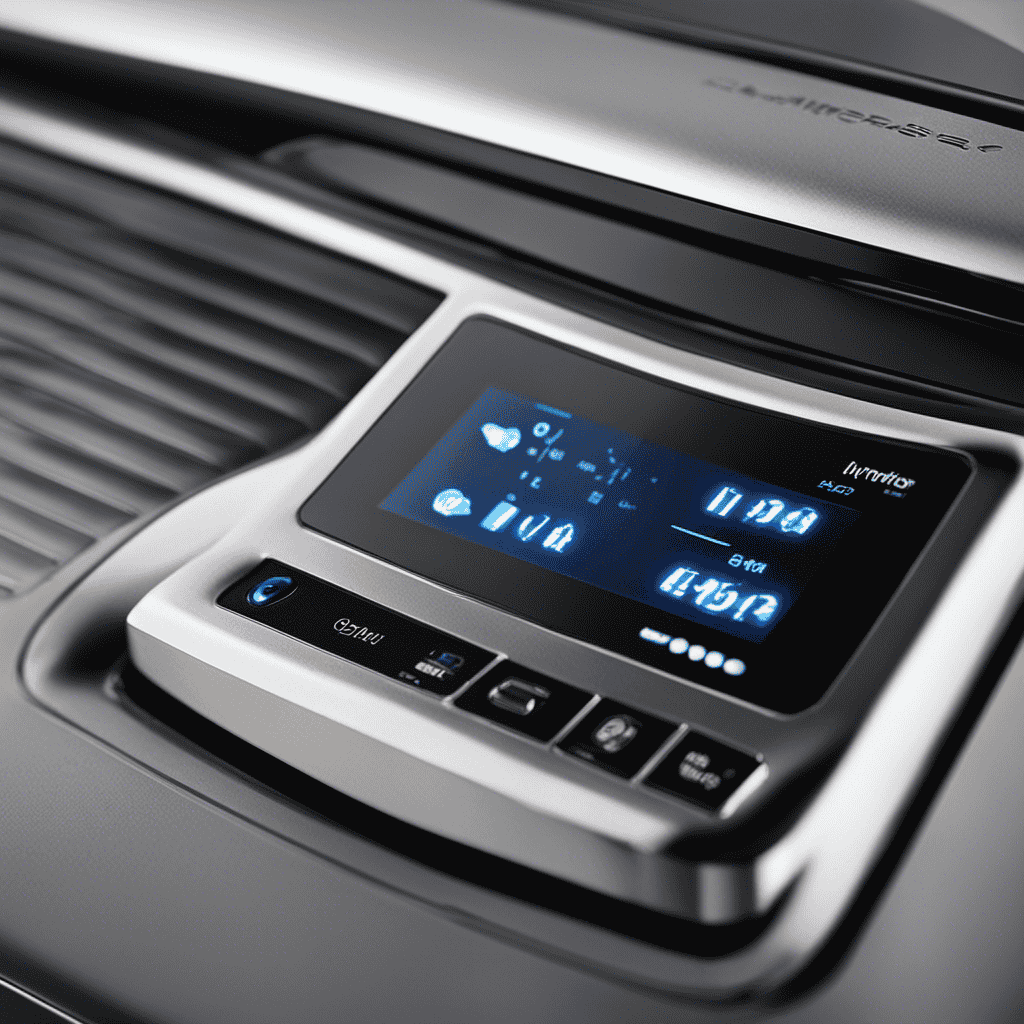Maintenance and Tips
How to Clean Permanent Filter Air Purifier

As someone who owns an air purifier, I’ve come to understand how crucial it is to consistently clean the permanent filter to guarantee it works at its best.
In this guide, I’ll share the step-by-step process I’ve perfected to keep my air purifier running efficiently.
You’ll discover the necessary tools and materials, along with valuable tips and tricks for maintenance.
Avoiding common mistakes is crucial, so let’s dive in and learn how to clean your permanent filter air purifier like a pro.
Key Takeaways
- Cleaning a permanent filter air purifier eliminates the need for constantly buying and replacing disposable filters.
- Permanent filters are more effective at capturing and removing airborne contaminants.
- Regular cleaning improves air purifier efficiency and extends its lifespan.
- Following the manufacturer’s recommendations for filter maintenance is important to ensure clean and fresh air for years to come.
Understanding the Importance of Cleaning a Permanent Filter Air Purifier
Understanding the importance of cleaning a permanent filter air purifier can help maintain its efficiency and prolong its lifespan. There are several benefits of using a permanent filter air purifier.
Firstly, it eliminates the need for constantly buying and replacing disposable filters, saving you money in the long run. Additionally, permanent filters are more effective at capturing and removing airborne contaminants such as dust, pollen, pet dander, and mold spores.
However, it is crucial to clean the permanent filter regularly to ensure optimal performance. The frequency of cleaning depends on various factors including the air quality in your home and the manufacturer’s recommendations. Generally, it is recommended to clean the permanent filter once every three to six months.
Regular cleaning not only improves air purifier efficiency but also extends its lifespan, ensuring clean and fresh air for years to come.
Gather the Necessary Tools and Materials for Cleaning
To start, you’ll need to gather all the tools and materials necessary for the cleaning process of your air purifier’s permanent filter. Here’s a list of what you’ll need:
- Soft-bristle brush: This will help remove loose debris and dust from the filter.
- Mild dish soap: A gentle soap will be effective in cleaning the filter without causing any damage.
- Warm water: This will be used to create a cleaning solution with the dish soap.
- Clean, lint-free cloth or sponge: This will be used to scrub the filter gently.
- Towels or drying rack: These will be needed for drying the filter after cleaning.
Cleaning frequency for permanent air purifier filters varies depending on the manufacturer’s recommendation. However, it is generally recommended to clean the filter every two to three months.
Now that you have gathered the necessary tools and materials, let’s move on to the step-by-step guide to cleaning the permanent filter.
Step-by-Step Guide to Cleaning the Permanent Filter
First, gather all the necessary tools and materials mentioned earlier in the list. Now, let’s move on to the step-by-step guide for cleaning your permanent filter air purifier. Cleaning the filter regularly is crucial to maintain its efficiency and prolong its lifespan. Here is a table that outlines the steps involved:
| Step | Procedure |
|---|---|
| 1. | Turn off and unplug the air purifier. |
| 2. | Remove the filter from the unit. |
| 3. | Use a vacuum cleaner or soft brush to remove dust and debris from the filter. |
| 4. | Rinse the filter under running water to remove stubborn dirt. |
| 5. | Allow the filter to dry completely before reinstalling it. |
| 6. | Plug in and turn on the air purifier. |
To ensure the best cleaning results, it is recommended to use the appropriate cleaning products, such as mild detergent or vinegar solution. As for the frequency, it is generally advised to clean the permanent filter every 3-6 months, or as indicated by the manufacturer. Following these steps and cleaning recommendations will help keep your air purifier running efficiently and maintain clean air quality in your home.
Tips and Tricks for Maintaining a Clean and Efficient Air Purifier
For optimal performance, make sure you regularly replace the carbon filters in your air purifier. Maintaining filter longevity is essential for improving indoor air quality.
Here are some tips and tricks to keep your air purifier clean and efficient:
- Vacuum the exterior of the air purifier to remove dust and debris.
- Wipe down the control panel and buttons with a damp cloth.
- Clean the pre-filter regularly to prevent clogging.
- Use compressed air to blow out any dust or debris from the filter.
- Consider using a filter indicator to track the lifespan of your filters.
By following these maintenance practices, you can ensure that your air purifier continues to work effectively and efficiently.
Now, let’s explore some common mistakes to avoid when cleaning a permanent filter air purifier.
Common Mistakes to Avoid When Cleaning a Permanent Filter Air Purifier
One common mistake people make when maintaining a permanent filter air purifier is neglecting to clean the exterior regularly. Proper cleaning techniques are essential to ensure the efficient operation of the device. Signs of a dirty filter include reduced airflow and an accumulation of dust and debris on the surface. To clean the exterior, use a soft, damp cloth to wipe away any dust or dirt. Avoid using harsh chemicals or abrasive materials that could damage the purifier. Additionally, regularly inspect and clean the filter according to the manufacturer’s instructions. This will help maintain the air purifier’s performance and prolong its lifespan. Remember, proper cleaning techniques and regular maintenance are crucial for optimal air quality in your home.
| PROPER CLEANING TECHNIQUES | SIGNS OF A DIRTY FILTER |
|---|---|
| Use a soft, damp cloth | Reduced airflow |
| Avoid harsh chemicals | Accumulation of dust |
| Follow manufacturer’s instructions | and debris on the surface |
Frequently Asked Questions
How Often Should I Clean My Permanent Filter Air Purifier?
I clean my permanent filter air purifier every 3 months to ensure optimal performance. Signs that it needs cleaning include reduced airflow and a noticeable increase in dust particles in the air.
Can I Use Regular Household Cleaning Products to Clean My Permanent Filter Air Purifier?
Yes, you can use regular household cleaning products to clean your permanent filter air purifier. However, using natural cleaning products has several benefits, such as being eco-friendly and reducing the risk of chemical exposure.
Is It Safe to Use Water to Clean the Permanent Filter of My Air Purifier?
Yes, it is safe to use water to clean the permanent filter of an air purifier. Regular maintenance is important for these filters, and alternative cleaning methods may also be used.
Can I Clean the Permanent Filter of My Air Purifier in the Dishwasher?
I wouldn’t recommend using the dishwasher to clean the permanent filter of your air purifier. It’s best to follow the manufacturer’s instructions for cleaning, or explore alternative cleaning methods that are safe and effective.
How Long Does It Take for the Permanent Filter of My Air Purifier to Dry After Cleaning?
After cleaning the permanent filter of my air purifier, it is important to properly dry it before reinserting. This ensures optimal performance and longevity. Here are some tips for maintaining the cleanliness of a permanent filter air purifier.
Conclusion
In conclusion, maintaining a clean and efficient air purifier is essential for improving indoor air quality. Cleaning a permanent filter air purifier is a relatively simple task that can be done in a few easy steps.
However, it is important to avoid common mistakes such as using harsh chemicals or not drying the filter properly.
Did you know that according to a study conducted by the Environmental Protection Agency, indoor air can be 2-5 times more polluted than outdoor air?
By regularly cleaning your air purifier, you can effectively remove pollutants and ensure a healthier living environment.
In the dynamic world of air purifiers and clean air advocacy, Aire stands out as a beacon of knowledge and passion. As the Editor in Chief of Aero Guardians, Aire has been instrumental in shaping the platform’s voice and direction, ensuring that every piece of content resonates with clarity, authority, and authenticity.
Maintenance and Tips
Should You Close or Open a Window When Using an Air Purifier
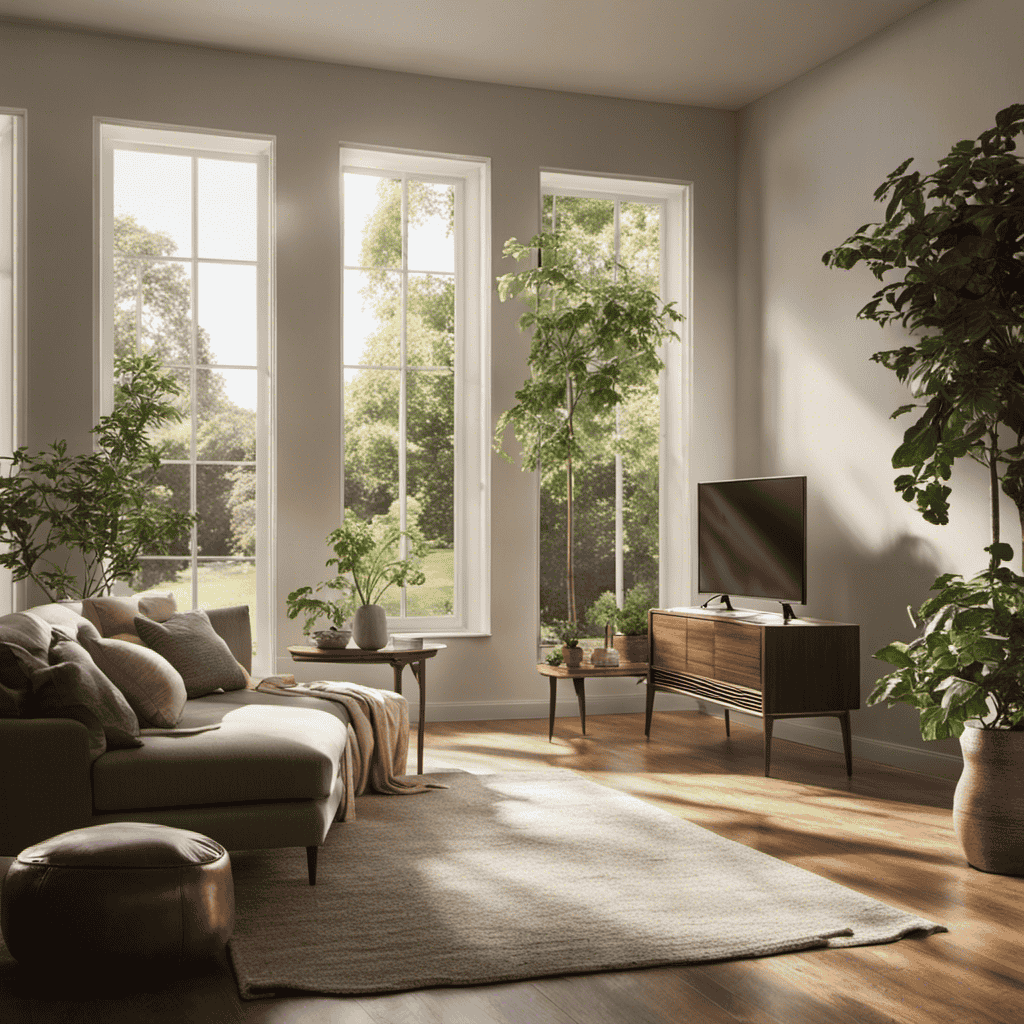
I understand your dilemma: should you keep the window open or closed when using an air purifier? This is a frequently asked question that requires a straightforward response.
In this article, I will provide you with evidence-based information on the benefits of using an air purifier, factors to consider, and the impact of closed and open windows on its performance.
By the end, you’ll have the best practices and tips to maximize the efficiency of your air purifier, regardless of your window preference.
Key Takeaways
- Closing windows significantly improves air purifier performance by preventing outside air with pollutants from entering the room.
- Open windows allow external pollutants to enter the room, undermining the purifier’s ability to clean the air effectively.
- Proper airflow is crucial for optimal air purifier performance and maintaining a constant flow of clean air.
- Consider outdoor air quality before deciding to open or close windows, and strategically position the air purifier near an open window for maximum effectiveness.
Benefits of Using an Air Purifier
Using an air purifier can help improve indoor air quality and reduce allergies and asthma symptoms. Air purifiers work by removing pollutants and allergens from the air, such as dust, pet dander, pollen, and mold spores. This can be especially beneficial for individuals with respiratory conditions or allergies, as it can help alleviate symptoms and improve overall well-being.
Studies have shown that air purifiers can effectively reduce particulate matter, volatile organic compounds (VOCs), and other harmful substances in the air. By improving air quality, air purifiers can create a healthier living environment and reduce the risk of respiratory problems.
Additionally, air purifiers can also help eliminate unpleasant odors, smoke, and harmful gases, further enhancing the overall indoor air quality. Therefore, investing in an air purifier can have numerous benefits for individuals seeking to improve their indoor air quality and reduce allergies and asthma symptoms.
Factors to Consider When Using an Air Purifier
When considering the use of an air purifier, it’s important to understand the relationship between window ventilation and the effectiveness of the purifier. Opening a window can increase the airflow in the room, which can help the purifier to circulate and filter the air more efficiently.
However, it’s also essential to consider the quality of the outdoor air and whether it contains pollutants that may compromise the purification process.
Window Ventilation and Purifier
To maximize the effectiveness of your air purifier, it’s important to consider the impact of window ventilation.
Window ventilation can have a significant effect on the air quality in your home. When using an air purifier, it is generally recommended to keep your windows closed to prevent outdoor pollutants from entering your space. This is especially important if you live in an area with high levels of air pollution or if you suffer from allergies or respiratory conditions.
Closing the windows helps create a controlled environment where the air purifier can efficiently clean the indoor air. However, if the outdoor air quality is good and you want to bring in fresh air, you can open the windows for short periods while the air purifier is still running. Just make sure to monitor the air quality and adjust accordingly to maintain a clean and healthy indoor environment.
Airflow and Purification Efficiency?
If your indoor air doesn’t have proper airflow, it may affect the efficiency of your air purification system. Ensuring good airflow control is essential for maintaining optimal indoor air quality.
Here are three reasons why proper airflow is crucial for air purification:
-
Increased circulation: Good airflow allows the air purifier to effectively circulate and filter the air in the room, capturing pollutants and allergens.
-
Improved filtration: Proper airflow ensures that all the air in the room passes through the purifier, maximizing its ability to remove contaminants and improve indoor air quality.
-
Enhanced purification efficiency: With proper airflow, the air purifier can operate at its highest efficiency, providing cleaner and healthier air to breathe.
Impact of Closed Windows on Air Purifier Performance
Closing the windows while using an air purifier can significantly improve its performance. When the windows are open, outside air containing pollutants can easily enter the room, making it more challenging for the air purifier to clean the air effectively.
Additionally, open windows can lead to window condensation, which can affect the air purifier’s filter lifespan. The moisture from condensation can cause the filter to become damp, reducing its efficiency and potentially leading to mold growth.
Impact of Open Windows on Air Purifier Performance
When it comes to the efficiency of air purifiers, airflow plays a crucial role.
The presence of open windows can significantly impact the performance of an air purifier by allowing external pollutants to enter the room.
These pollutants can undermine the purifier’s ability to clean the air effectively, reducing its overall efficiency.
Airflow and Purifier Efficiency
To maximize the efficiency of your air purifier, ensure that the airflow is not obstructed by keeping the window open. Here are three reasons why maximizing airflow is crucial for optimal air purifier performance:
-
Proper air circulation: When the window is open, fresh air can freely enter the room, allowing the air purifier to effectively capture and filter pollutants. This helps to maintain a constant flow of clean air throughout the space.
-
Enhanced purification: With increased airflow, the air purifier can efficiently cycle the air, removing more allergens, dust, and other particles. This leads to a healthier indoor environment and reduces the risk of respiratory issues.
-
Optimal placement: By placing the air purifier near the open window, you can further improve its performance. This strategic placement allows the purifier to draw in external pollutants before they enter the room, maximizing its effectiveness.
External Pollutants Entering in
External pollutants can significantly degrade the quality of the air in your living space. When considering whether to close or open a window when using an air purifier, it’s important to understand how external pollutants can enter your home. These pollutants can come from various sources such as traffic emissions, industrial activities, and even natural events like wildfires. Opening a window for ventilation can introduce these pollutants into your space, reducing the effectiveness of your air purifier. To illustrate the potential impact, consider the following table:
| External Pollutants | Potential Sources |
|---|---|
| Particulate matter | Traffic emissions, industrial activities |
| Volatile organic compounds (VOCs) | Cleaning products, paints, solvents |
| Carbon monoxide | Vehicle exhaust, faulty appliances |
| Nitrogen dioxide | Vehicle emissions, gas stoves |
| Ozone | Industrial emissions, chemical reactions |
Best Practices for Window Usage With an Air Purifier
If you want to optimize the effectiveness of your air purifier, it’s best to keep the windows closed while it’s running. Here are three reasons why window placement and airflow control are crucial for maximizing the benefits of your air purifier:
-
Preventing outdoor pollutants: Closing the windows ensures that external pollutants such as dust, pollen, and smoke are kept outside, allowing the air purifier to focus on cleaning the indoor air.
-
Controlling airflow: By keeping the windows closed, you can better regulate the airflow in your home. This allows the air purifier to circulate and filter the air more efficiently, ensuring that all areas of the room receive the purified air.
-
Avoiding cross-contamination: Opening windows while the air purifier is running can introduce new pollutants into the room, reducing the effectiveness of the purifier. Closing the windows creates a controlled environment where the air purifier can work at its best.
Tips for Maximizing Air Purifier Efficiency With Closed Windows
By following these tips, you can get the most out of your air purifier with closed windows.
When using an air purifier with closed windows, it’s important to place the device in the room where you spend the most time. This will ensure that you’re breathing in the cleanest air possible.
Additionally, make sure to keep the windows tightly closed to prevent outdoor pollutants from entering your space.
Regularly clean and maintain your air purifier to ensure optimal performance. Replace filters as recommended by the manufacturer to keep your air purifier working efficiently.
Tips for Maximizing Air Purifier Efficiency With Open Windows
Placing the air purifier near the open window can help to improve its efficiency. Here are three tips for maximizing airflow and optimizing its performance when using an air purifier with open windows:
-
Position the air purifier strategically: Place the air purifier close to the open window to allow for better air circulation. This will help the purifier to effectively capture and filter out pollutants from the incoming air.
-
Adjust the window opening: Experiment with different window openings to find the sweet spot that allows for maximum airflow without creating drafts. A slightly open window can provide a steady flow of fresh air while maintaining a controlled environment inside.
-
Consider outdoor air quality: Before using the air purifier with open windows, check the outdoor air quality. If there are high levels of pollutants or allergens, it may be best to keep the windows closed and rely solely on the purifier’s filtration system.
Conclusion: Finding the Right Window Approach for Your Air Purifier
To find the right window approach for optimal air purifier performance, I recommend experimenting with different window openings and checking the outdoor air quality.
Window placement plays a crucial role in ensuring that your air purifier works efficiently. By strategically positioning your air purifier near an open window, you can maximize its ability to capture and filter out airborne pollutants.
However, it’s important to consider noise reduction as well. Opening the window too wide may increase the noise level, especially if you live in a noisy area. Therefore, it is advisable to strike a balance between window opening size and noise reduction.
Frequently Asked Questions
How Do I Determine if I Need an Air Purifier in My Home?
To determine if I need an air purifier, I consider factors like allergies, asthma, and air quality. The benefits of using one include removing pollutants, improving indoor air quality, and reducing symptoms.
Can Air Purifiers Remove All Types of Pollutants From the Air?
Air purifiers are effective at removing many types of pollutants from the air, but they have limitations. Some pollutants, like gases and odors, are more difficult to remove. It’s important to consider the specific needs of your home when using an air purifier.
Is It Safe to Leave an Air Purifier on All the Time?
It’s amazing how leaving an air purifier on all the time can improve indoor air quality over time. The pros include continuous filtration, but cons may include increased energy consumption and noise.
How Often Should I Replace the Filters in My Air Purifier?
When to replace air purifier filters and what are the signs of a dirty air purifier filter? It is important to regularly check the filters and replace them when they appear dirty or clogged.
Can Air Purifiers Help Reduce Allergens in the Air?
When using an air purifier, it is important to consider whether to close or open a window. Closing the window helps the purifier work more effectively by preventing outdoor allergens, like pet dander, from entering.
Conclusion
In conclusion, after thorough research and analysis, it’s clear that the decision to open or close a window when using an air purifier ultimately depends on your specific needs and circumstances.
Closed windows may provide a more controlled environment for the air purifier to effectively filter the air. This can help ensure that the purifier is able to efficiently remove pollutants and improve the air quality in your space.
On the other hand, open windows can introduce fresh air and improve ventilation. This can be beneficial in certain situations, such as when there are strong odors or when you want to increase airflow in a stuffy room.
However, it’s important to note that open windows may also bring in pollutants from outside. This can include allergens, dust, and other contaminants that can undermine the effectiveness of your air purifier.
Therefore, it’s crucial to strike a balance and find the right approach that suits your air purification goals and maintains a healthy indoor environment. Consider factors such as the outdoor air quality, your specific sensitivities or allergies, and the effectiveness of your air purifier. By doing so, you can make an informed decision on whether to open or close your windows when using an air purifier.
In the dynamic world of air purifiers and clean air advocacy, Aire stands out as a beacon of knowledge and passion. As the Editor in Chief of Aero Guardians, Aire has been instrumental in shaping the platform’s voice and direction, ensuring that every piece of content resonates with clarity, authority, and authenticity.
Maintenance and Tips
Swiffer Air Purifier What Do Lights Mean Thew Front
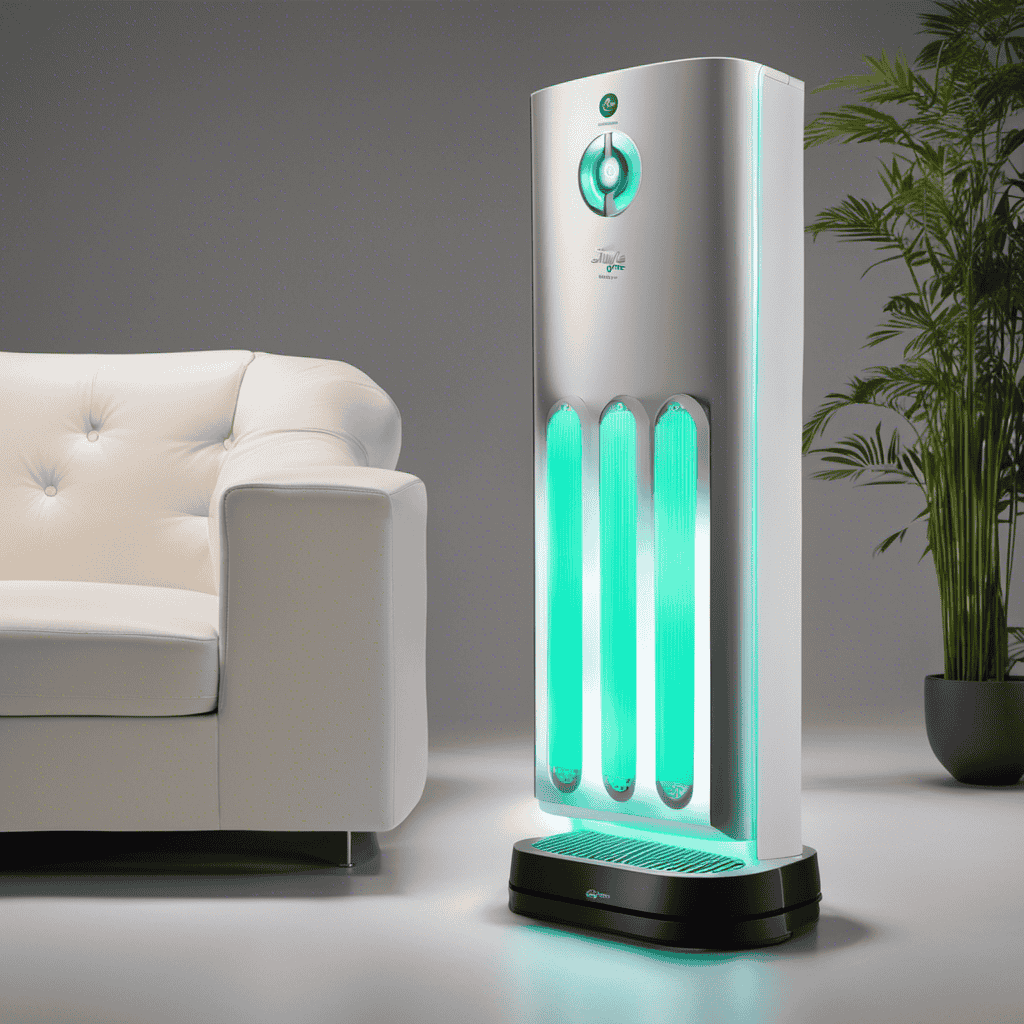
As I entered my living room, I couldn’t help but notice the illuminated lights on my Swiffer Air Purifier. I was curious about their significance and how they could potentially enhance the air quality in my home.
In this article, I will guide you through the process of understanding and decoding the indicator lights on the front panel of the Swiffer Air Purifier. By the end, you will be able to make sense of the LED signals and decipher the front panel indicators with ease.
Let’s dive in and shed light on what these lights really mean.
Key Takeaways
- Indicator lights on the Swiffer Air Purifier provide valuable information about its performance and help troubleshoot issues.
- LED signals on air purifiers have different meanings, such as green indicating normal operation and red signaling a problem or error.
- The front panel lights on the Swiffer Air Purifier assist in troubleshooting common issues and adjusting settings for optimal air purification.
- Understanding the meanings of the different colored lights on the Swiffer Air Purifier helps effectively use and maintain the device.
Understanding the Indicator Lights
The lights on the front of the Swiffer air purifier indicate different modes and settings. Understanding the symbols and color codes is essential for proper operation.
The first symbol is a power button, usually represented by a circle or a switch. When it’s illuminated, it means the air purifier is turned on.
The color codes are often used to indicate the air quality. A green light signifies that the air is clean, while a yellow light indicates moderate air quality, and a red light means the air is polluted.
Some models also have additional symbols, such as a fan icon to show the speed settings.
These lights and symbols help users interpret the air purifier’s status and make informed decisions about their indoor air quality.
Now let’s move on to decoding the light patterns and what they mean.
Decoding the Light Patterns
To understand the light patterns on your Swiffer air purifier, you can refer to the manual for a clear explanation.
The light patterns on the front of the unit are designed to provide you with important information about the current status and settings of the purifier.
The LED lights on the Swiffer air purifier have different meanings based on their colors and blinking patterns.
For example, a solid green light indicates that the purifier is working properly and the air quality is good.
A blinking red light, on the other hand, may indicate that the filter needs to be replaced or that there is an issue with the unit.
It is important to pay attention to these light patterns as they can help you troubleshoot any problems and ensure that your air purifier is functioning optimally.
Interpreting the Front Panel Lights
You can easily understand the light patterns on your Swiffer air purifier by referring to the manual and paying attention to the different colors and blinking patterns.
The front panel of the purifier contains various buttons and symbols that control its functions. One of the most important features is the light symbol interpretations. These lights provide important information about the air purifier’s status and performance.
For example, a solid green light indicates that the purifier is working properly and the air is clean. A blinking red light, on the other hand, suggests that the filter needs to be replaced.
Meaning of the LED Signals
When it comes to understanding the LED signals on devices, such as air purifiers or other electronic gadgets, it’s important to know how to interpret these light indicators.
LED signals can provide valuable information about the device’s status, notifications, and functionalities.
In this discussion, we will delve into the various LED signal interpretations, explain the meaning behind different light indicators, and help you gain a better understanding of how to interpret LED notifications accurately.
LED Signal Interpretations
Take a look at the front of the Swiffer Air Purifier to understand what the different lights mean. The LED signal analysis is crucial for interpreting the light codes.
These lights serve as indicators to communicate important information about the purifier’s status. When the purifier is operating normally, you will see a steady blue light, indicating that it is functioning properly.
However, if you notice a blinking red light, it signifies that the filter needs to be replaced. Additionally, a blinking yellow light indicates that the purifier is in sleep mode.
Understanding these light codes is essential for maintaining the optimal performance of your Swiffer Air Purifier.
Now, let’s delve into further details about the various light indicators explained in the subsequent section.
Light Indicators Explained
The LED light codes on the front of the Swiffer Air Purifier provide important information about its status. These light indicators are designed to help users troubleshoot any issues that may arise. Here are some troubleshooting tips and what each light indicator means:
| Light Indicator | Status | Meaning |
|---|---|---|
| Green | Solid | Purifier is on and operating normally |
| Blue | Flashing | Air quality is good |
| Yellow | Flashing | Air quality is fair |
| Red | Flashing | Air quality is poor |
| Red | Solid | Filter needs to be replaced |
Understanding these light indicators is crucial for maintaining a clean and healthy environment. By paying attention to the LED notifications, you can easily determine the status of your air purifier and take appropriate action. Now, let’s delve into a deeper understanding of these LED notifications in the next section.
Understanding LED Notifications
To better understand the LED notifications, you can refer to the chart provided with detailed explanations of each light indicator’s meaning. This chart is a valuable resource that allows you to easily interpret the various light symbols on the Swiffer Air Purifier.
Here are three key functions of the LED indicators:
-
Power Status: The LED light will indicate whether the device is powered on or off.
-
Filter Replacement: The LED light will notify you when it’s time to replace the filter, ensuring optimal performance.
-
Air Quality: The LED light will provide real-time feedback on the air quality in your surroundings, helping you maintain a clean and healthy environment.
Making Sense of the Illumination
When it comes to understanding the LED signals on devices, such as air purifiers or appliances, it’s important to grasp the meaning behind different light colors.
In this discussion, we will explore the explanations behind various light colors, enabling a better understanding of what each color represents.
Additionally, we will delve into the topic of indicator lights and how to interpret their signals, as well as decoding the specific messages conveyed by LED lights.
Light Color Explanations
Check out the front of the Swiffer Air Purifier to see what the different light colors mean. The light color significance is an important aspect of understanding the performance of your air purifier. Here is a troubleshooting guide to help you interpret the light colors:
-
Blue Light: Indicates that the air purifier is functioning properly and the air quality is good.
-
Red Light: Indicates that the air quality is poor and the air purifier is working hard to clean the air. It is recommended to keep the purifier running until the light turns blue.
-
Yellow Light: Indicates that the filter needs to be replaced soon. It is recommended to order a new filter and replace it as soon as possible.
Understanding Indicator Lights
Understanding the indicator light colors is essential for interpreting the performance of the air purifier. The indicator lights on the front of the Swiffer Air Purifier are designed to help users troubleshoot any issues that may arise. These lights provide valuable information about the purifier’s current state and can help users identify any problems that need to be addressed. To make it easier for users to understand the different indicator light meanings, I have created a table below:
| Indicator Light Color | Meaning |
|---|---|
| Green | The air purifier is functioning properly |
| Yellow | The filter needs to be replaced soon |
| Red | The filter needs to be replaced immediately |
Decoding LED Signals
In my previous subtopic, I discussed the importance of understanding indicator lights on electronic devices. Now, let’s delve deeper into decoding LED signals specifically.
LED lights on devices, such as the Swiffer Air Purifier, often have different meanings depending on their patterns. Here’s what you need to know:
- Green light: Indicates that the device is operating normally and purifying the air effectively.
- Red light: Signals a problem or error, such as a clogged filter or low battery. It’s essential to address the issue promptly.
- Flashing lights: Can indicate various things, such as a malfunction or the need for maintenance. Consult the product manual for specific meanings.
Interpreting these light patterns is crucial for troubleshooting and ensuring optimal performance. By understanding the LED signal meanings, you can take appropriate actions to keep your Swiffer Air Purifier running smoothly and efficiently.
Deciphering the Front Panel Indicators
The lights on the front panel of the Swiffer air purifier tell you what each indicator means. When it comes to troubleshooting common issues, the lights can be your guide.
For example, if the power indicator light is not illuminating, it could mean that there is a problem with the power supply or the unit itself. In this case, you should try unplugging the purifier and plugging it back in to see if that resolves the issue.
Additionally, adjusting the settings for optimal air purification is also made easier with the help of the front panel lights. The fan speed indicator light allows you to select the desired level of air circulation, from low to high, depending on your preferences and the size of the room.
What the Lights on the Swiffer Air Purifier Indicate
Now that we understand how to interpret the front panel indicators on the Swiffer Air Purifier, let’s delve into what the lights actually mean.
The LED signals emitted by the device can provide valuable information about its current status and help troubleshoot any issues. Here are some key points to consider:
-
Light Color Meanings:
-
Green: Indicates that the air purifier is operating normally and the air quality is good.
-
Yellow: Suggests moderate air pollution and that the purifier is working to improve the air quality.
-
Red: Indicates high levels of air pollution and that the purifier is working at its maximum capacity to cleanse the air.
-
Troubleshooting LED Signals:
-
Blinking Yellow: May indicate a filter replacement is needed.
-
Blinking Red: Indicates a malfunction or error in the device that requires attention.
-
Solid Red: Signifies a critical issue that needs immediate resolution.
Understanding these light color meanings and troubleshooting LED signals will help you effectively use and maintain your Swiffer Air Purifier.
Frequently Asked Questions
How Do I Interpret the Blinking Light Patterns on the Swiffer Air Purifier?
To interpret blinking light patterns on the Swiffer Air Purifier, I troubleshoot unresponsive LED signals. By referring to the user manual or contacting customer support, I can understand what different light patterns indicate for optimal performance.
What Does It Mean When the Front Panel Lights on the Swiffer Air Purifier Are Solid Red?
When the front panel lights on my Swiffer Air Purifier are solid red, it means there is an issue that requires troubleshooting. Understanding blinking patterns can help identify the specific problem and find a solution.
Can I Adjust the Brightness of the LED Lights on the Swiffer Air Purifier?
Yes, you can adjust the brightness of the LED lights on the Swiffer Air Purifier. It allows for customization to suit your preference and create the desired ambiance in your space.
Are There Any Specific Troubleshooting Steps I Should Follow if the Indicator Lights on My Swiffer Air Purifier Are Not Working?
If the indicator lights on my Swiffer Air Purifier are not working, I would follow these troubleshooting steps: check the power source, ensure the lights are properly connected, and contact customer support if the issue persists.
Is There a Way to Reset the LED Signals on the Swiffer Air Purifier if They Become Unresponsive?
Yes, there is a way to reset the LED signals on the Swiffer Air Purifier if they become unresponsive. Troubleshooting unresponsive lights can be done by following specific steps provided in the user manual.
Conclusion
In conclusion, the Swiffer Air Purifier’s indicator lights serve as a helpful guide in understanding the device’s functionality. By decoding the light patterns and interpreting the front panel lights, users can quickly determine the status of their air purifier.
These LED signals are like a beacon in the night, illuminating the path to cleaner and fresher air. So, next time you see those lights, don’t fret, just refer to the manual and let the Swiffer Air Purifier work its magic.
In the dynamic world of air purifiers and clean air advocacy, Aire stands out as a beacon of knowledge and passion. As the Editor in Chief of Aero Guardians, Aire has been instrumental in shaping the platform’s voice and direction, ensuring that every piece of content resonates with clarity, authority, and authenticity.
Maintenance and Tips
Safe to Leave Air Purifier on When Not Home
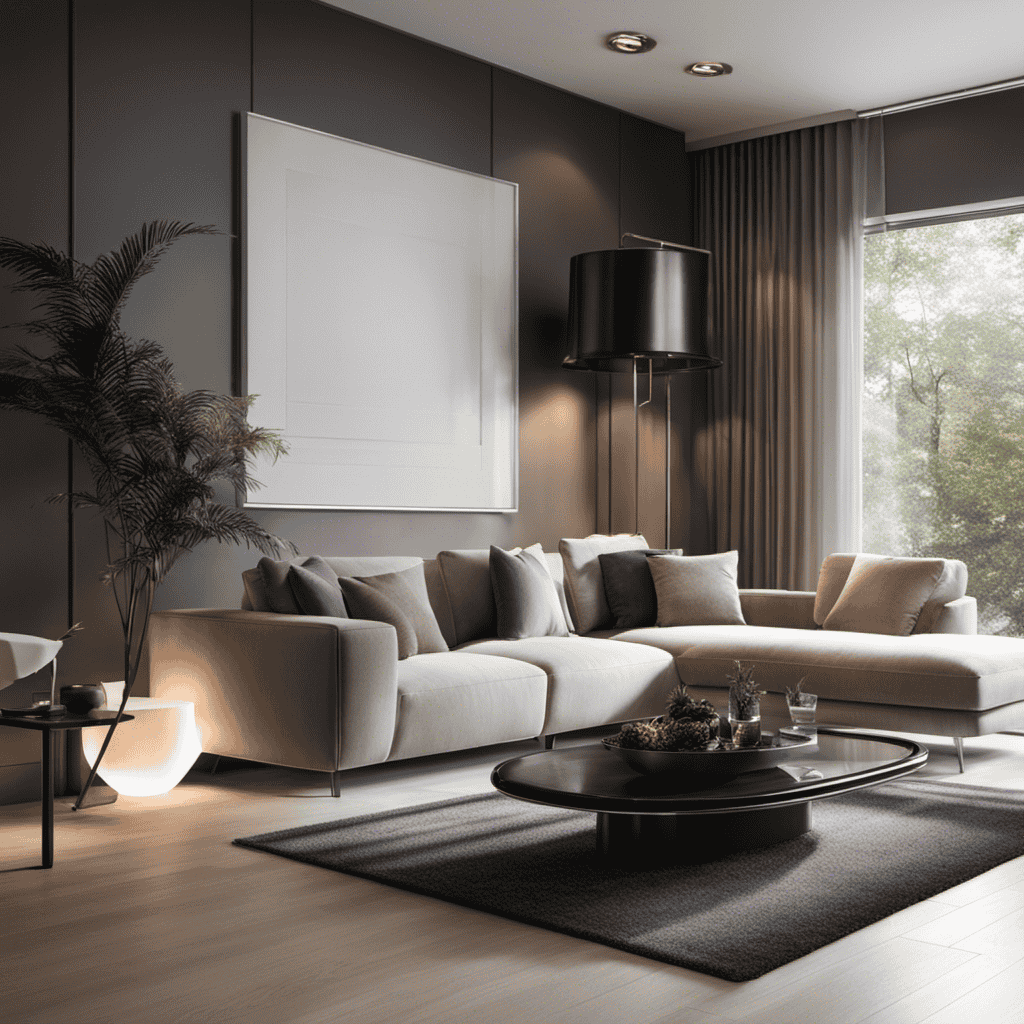
I have always been curious about the safety and effectiveness of leaving my air purifier running while I am away from home. Will it make a significant difference in the quality of the air? Is it worth the cost in terms of energy consumption and impact on my bills? And most importantly, is it safe to do so?
In this article, we will delve into the science behind leaving your air purifier on while you’re away, address any safety concerns, and provide tips on extending its lifespan.
Let’s make an informed decision together.
Key Takeaways
- Regular maintenance and cleaning of the air purifier are crucial for safe operation.
- Clogged filters can reduce effectiveness, cause overheating, and breed bacteria and mold.
- Following manufacturer guidelines for filter replacement and cleaning is essential for safety and optimal performance.
- Turning off the air purifier when not needed ensures both safety and energy efficiency.
The Benefits of Leaving Your Air Purifier On While You’re Away
You’ll be pleased to know that leaving your air purifier on while you’re away can provide numerous benefits.
Not only does it contribute to energy efficiency, but it also helps maintain excellent air quality.
Modern air purifiers are designed with advanced technology that allows them to operate efficiently even when left unattended.
With features such as automatic sensors and timers, these devices can monitor and adjust the purification process based on the air quality in your home.
This ensures that the air remains clean and free from pollutants, allergens, and harmful particles, even when you’re not there to manually control it.
Understanding the Energy Consumption of Air Purifiers and Its Impact on Your Bills
It’s important to understand how much energy air purifiers consume and how it can affect your monthly bills. When it comes to energy consumption, not all air purifiers are created equal. Opting for energy efficient air purifiers can help minimize the impact on your utility bills. These purifiers are designed to use less electricity while still effectively cleaning the air.
Additionally, managing your air purifier settings can also help reduce energy consumption. For example, adjusting the fan speed to a lower setting can decrease energy usage without compromising air quality. By being mindful of energy efficient options and optimizing your settings, you can enjoy clean air while keeping your energy costs in check.
Now, let’s address the safety concerns: Is it safe to leave your air purifier unattended?
Addressing Safety Concerns: Is It Safe to Leave Your Air Purifier Unattended
When you’re away, it’s important to ensure that your air purifier is turned off to prevent any potential hazards. While air purifiers are designed to improve indoor air quality, leaving them unattended can pose certain risks.
Regular air purifier maintenance is crucial to ensure their safe operation. Over time, filters can become clogged with dust, allergens, and pollutants, reducing their effectiveness and potentially causing overheating. Additionally, accumulated particles in the filters can serve as a breeding ground for bacteria and mold, leading to the release of harmful microorganisms into the air. Therefore, it is essential to follow manufacturer guidelines for filter replacement and cleaning.
Moreover, air purifiers consume electricity, and leaving them on when not needed can result in unnecessary energy usage and increased utility bills. To ensure your safety and optimize energy efficiency, it’s best to turn off your air purifier when you’re away.
Extending the Lifespan of Your Air Purifier: Tips for Leaving It On When Not Home
To maximize the lifespan of your air purifier while you’re away, ensure proper airflow by positioning it away from walls and furniture. Maintaining the efficiency of your air purifier is crucial, especially when it’s left on for extended periods. By following recommended maintenance practices, you can ensure that your air purifier continues to function optimally.
Here are some tips for maximizing efficiency and extending the lifespan of your air purifier:
| Tips for Extending Lifespan of Air Purifier |
|---|
| Clean or replace filters regularly |
| Keep the unit dust-free |
| Avoid placing it near sources of heat |
Regularly cleaning or replacing the filters is essential to ensure that the air purifier can effectively remove pollutants from the air. Dust can accumulate on the unit and hinder its performance, so it’s important to keep it clean. Additionally, placing the air purifier away from heat sources can prevent damage and ensure its longevity.
Making an Informed Decision: Factors to Consider Before Leaving Your Air Purifier On
If you’re considering leaving your air purifier on while you’re away, there are several important factors you should take into account. To make an informed decision, consider the following factors:
-
Energy Efficiency: Leaving your air purifier on when not home can consume a significant amount of energy. Check the energy rating of your purifier and calculate the energy consumption based on the duration it will be running.
-
Air Quality: Assess the air quality in your home. If you live in an area with high pollution or have allergies, it may be beneficial to leave the purifier on to maintain clean air even when you’re not there.
-
Noise Level: Consider the noise produced by the air purifier. Some models can be quite loud, which may be disruptive if you have neighbors or family members who are sensitive to noise.
Frequently Asked Questions
How Long Can I Safely Leave My Air Purifier on When I’m Not at Home?
When I’m not home, I can safely leave my air purifier on for extended periods, as long as it is energy-efficient and doesn’t produce excessive noise. Considering energy consumption and noise levels is crucial.
Can Leaving My Air Purifier on for Extended Periods of Time Lead to Any Health Risks?
Leaving my air purifier on for extended periods may not pose health risks, but it can impact its lifespan. However, studies suggest that continuous operation improves effectiveness in removing pollutants and maintaining air quality.
Are There Any Potential Fire Hazards Associated With Leaving an Air Purifier on Unattended?
Leaving an air purifier unattended can pose fire risks and safety concerns. It is crucial to consider the potential hazards associated with prolonged use, such as overheating or electrical malfunctions.
Will Leaving My Air Purifier on Constantly Increase My Electricity Bill Significantly?
Leaving my air purifier on constantly won’t significantly increase my electricity bill. In fact, using it consistently has long-term benefits, like improving air quality, reducing allergens, and extending the purifier’s lifespan.
Can Leaving an Air Purifier on for Long Periods of Time Lead to Any Negative Effects on the Air Quality in My Home?
Leaving an air purifier on for long periods of time may not have negative effects on air quality. However, it’s best to check the manufacturer’s instructions and consider factors like filter maintenance and room size.
Conclusion
In conclusion, after carefully considering the benefits, energy consumption, safety concerns, and tips for extending the lifespan of your air purifier, I am convinced that it is safe and advantageous to leave it on while you’re away.
Like a guardian angel, the air purifier diligently works to cleanse the air, creating a haven of purity and freshness.
Its energy consumption is minimal, ensuring your bills remain untouched.
By following the recommended maintenance and safety guidelines, you can enjoy the long-lasting benefits of your air purifier, even when you’re not home.
At Aero Guardians, where every piece of information aims to make the world a breath fresher, Samuela’s role as an author has been nothing short of transformative. With a penchant for weaving stories around the science of air purification, Samuela has enriched the platform with content that is both enlightening and captivating.
-

 Types of Air Purifiers1 month ago
Types of Air Purifiers1 month agoWhat Is an Air Purifier
-

 Air Purifier Guides4 weeks ago
Air Purifier Guides4 weeks agoHow to Reset Filter on Miko Air Purifier
-

 Air Purifier Guides3 months ago
Air Purifier Guides3 months agoHow to Make a Homemade Ozone Generator (Air Purifier
-

 Vetted3 months ago
Vetted3 months agoAera Mini Review: Smart Home Fragrance Diffuser With Hypoallergenic Scent Technology (2023)
-

 FAQs - Advanced Queries3 months ago
FAQs - Advanced Queries3 months agoWhat Do the Numbers on My Air Purifier Mean
-

 Maintenance and Tips3 months ago
Maintenance and Tips3 months agoHow to Reset Filter Light on Winix Plasmawave Air Purifier
-

 FAQs - Advanced Queries3 months ago
FAQs - Advanced Queries3 months agoWhen to Use Ionizer on Coway Air Purifier
-
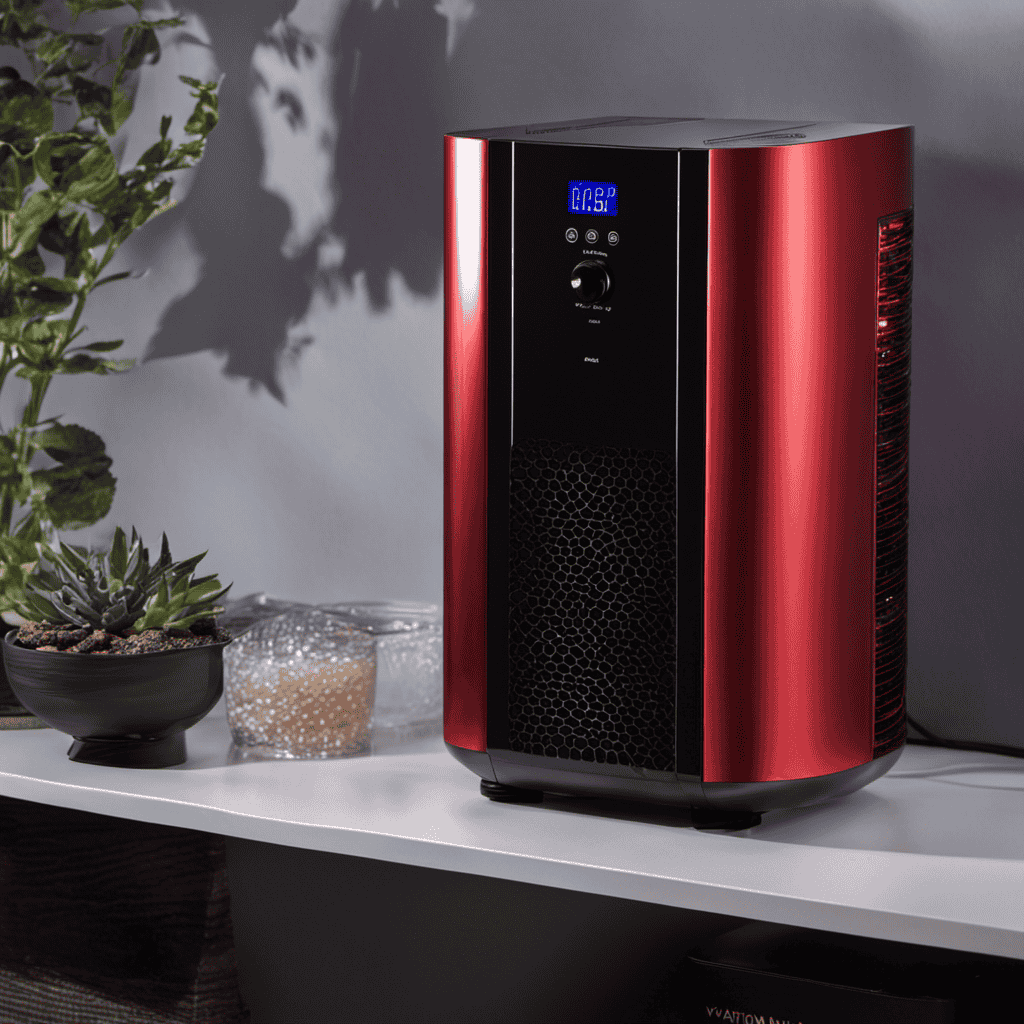
 FAQs - Advanced Queries3 weeks ago
FAQs - Advanced Queries3 weeks agoWhy Is Ivation Ozone Generator Air Purifier “Red” Light Not on







